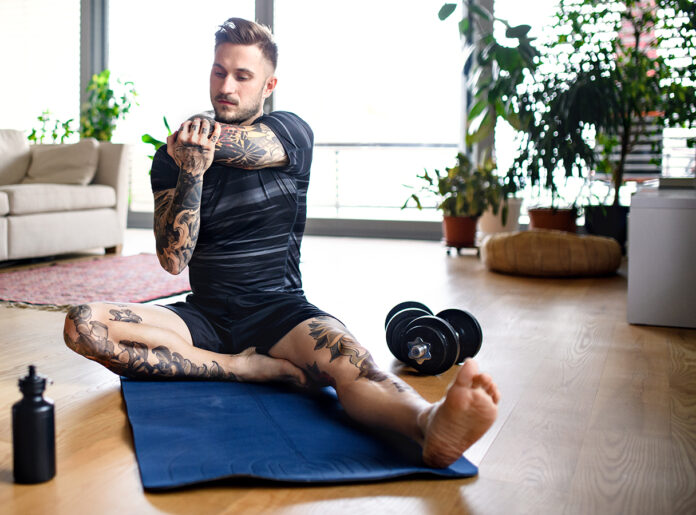
The body needs a lot of movement to keep it working well. Just like a well-balanced diet includes different foods, each with their own necessary nutrients, a well-balanced movement diet includes a variety of movements that challenge all of our parts—and we have a lot of parts!
We all know the term cross-training. Cross-training is an exercise technique that calls for a variance of exercise type (and sometimes a variance of the way you do one type of activity) to improve the body’s response to exercise and decrease injury. Cross-training is often recommended by exercise and therapeutic professionals because being strong or healthy in one specific way doesn’t transfer over to being strong or healthy in every way. For example, if you’re a kick-ass runner and you run all the time and you run easily and without pain, your body is probably very adapted to the tissue strengths necessary to run. But say you help a friend move and in lifting a few boxes you are thrown out of commission for a month with a major back spasm. Weren’t you strong? Weren’t you in shape? Weren’t you a regular mover, and doesn’t that mean you were conditioned to move?
The answer to all of these questions has to do with the Law of Specificity, which dictates that you get better at what you do and not better at what you don’t. A particular way of moving creates loads and adaptations in only the tissues pulled and pushed and compressed by that activity. The more you do the same thing repeatedly, the stronger some areas of your body become. As with any kind of material—cloth, metal, wood—strength in one area increases the relative weakness of the surrounding areas not strengthened. Having strong, regularly-used parts next to underused (or overused) weak ones can actually increase tissue damage by creating a natural stress riser. The more parts you integrate into your movement, the less disparity between parts. This is why experts have recommended changing up your workout (i.e., cross-training) for years: to close the strength gaps that live between the exercises you do and exercises you don’t.
The gap between what you are physically doing right now and what your body can do is vast. Typically, cross-training is applied to your workout: “If you usually run, you should throw in some strength training,” or “If you are a cyclist, you should balance your workout with yoga.” Again, the sentiment is correct. Look at what you are doing and then round out the loads applied to the body by doing something different. The problem is most of what we do for exercise is just slightly different versions of the same kinds of motions.
The answer to all of these questions has to do with the Law of Specificity, which dictates that you get better at what you do and not better at what you don’t.
There is rarely uniqueness to what we do, and even routines designed to recruit more of our bodies often fail to do so because our movement patterns are so ingrained that we don’t perform the program’s movements as intended. Moving differently requires an inordinate amount of mindfulness, and once we forget to pay attention, we automatically default to the same pattern and go back to increasing the difference between one and every other area of our body. We go back to making stress risers. To determine where we move a lot and where we move a little, we must look beyond our exercise session to the frequencies of movement, ranges of motion, and the way we load our body throughout the day, every day, over a lifetime.
Exercise is one type of movement. Exercise, by definition, is planned, structured, repetitive, and purposive in the sense that improvement or maintenance of one or more components of physical fitness is an objective. We tend to have preferred modes or types of exercise—running, biking, pickleball—that use particular parts of our body and increase our physical fitness. But even the most diligent exercisers can still be sedentary the rest of the day and can have many stiff and underused body parts right next to the parts used for their favourite activities.
How do we deal with our sedentary parts? Instead of just balancing your workouts over the week with different modes of exercise, you can “cross-train” your movement over the day. If your exercise session is surrounded by hours spent sitting in a car, at work, and at home, work to reduce that repetitive “chair” input. Forgo the car for an easy walk to and from the store for groceries and give your cycling or swimming legs more weight-bearing time. Lots of exercise tends to be leg-heavy. Look for opportunities to carry. Holding a bag of groceries or library books is a quick core and arm workout, but there’s no “exercise mode” or need to step away from your other daily to-do list. Sitting on the floor when taking in your evening Netflix or while working on your computer—legs crossed, in a V-shape, and then straight out in front—gets the hips and knees some of the recovery stretching they can use, extra time not required.
Keeping a body moving well requires regular movement that’s distributed both throughout the body and throughout the day. Swaddle your exercise time with more dynamic activities of daily living so that a workout isn’t the only peak on the “how much did I move today” graph, and the bulk of your non-exercise time isn’t shaping your tissues into the same use patterns repeatedly.
You May Also Like
WORKOUTS

Read This Story in Our 2022 Fall Fitness & Food Digital Edition
Featuring Brendan Brazier, athlete and pioneer in the plant-based sports nutrition industry. Trail Running 101 – plus this year’s Trail Running Shoe Review. Travel around the world to the top vegan-friendly destinations, recipes and much more!
















